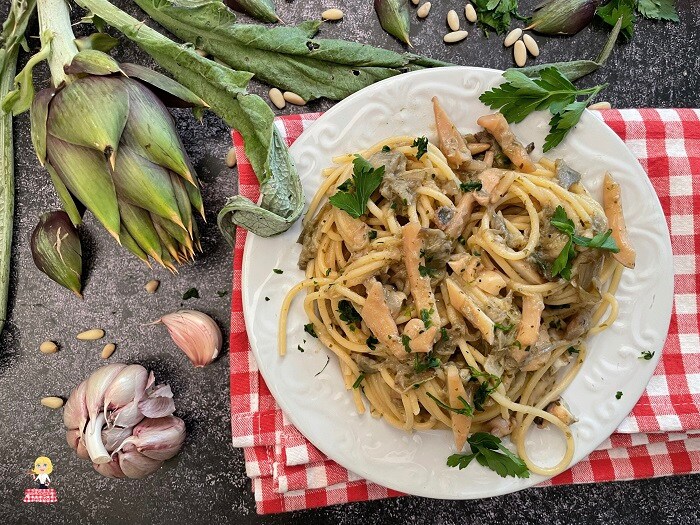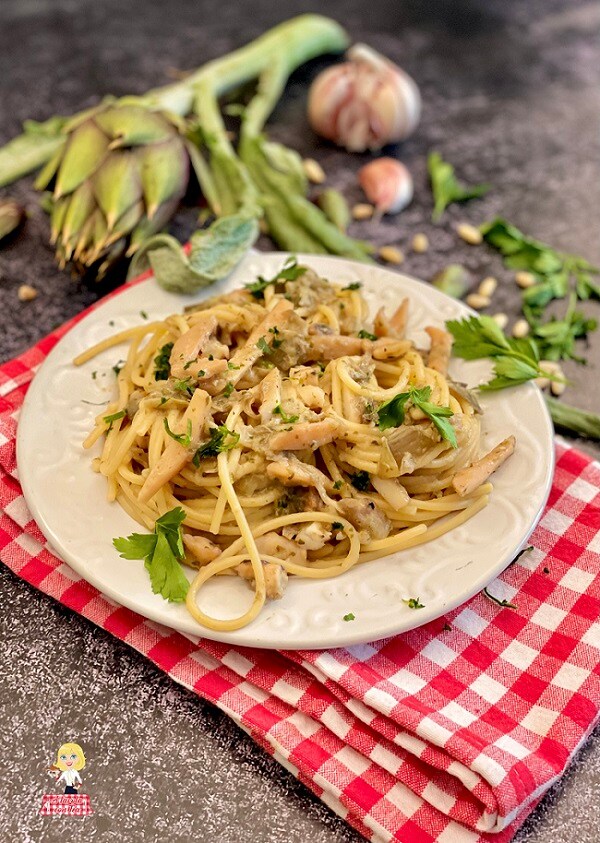PASTA WITH ARTICHOKES AND CUTTLEFISH
The Pasta with Artichokes and cuttlefish is a light yet flavorful first course, extremely easy to prepare where the bitter and delicate taste of the artichoke perfectly matches with this delightful mollusk.
How to make pasta with artichokes? It’s very easy and quick and requires just a few simple ingredients.
Having made this necessary introduction, to prepare the pasta with Artichokes you will obviously need to clean them by removing the stem and outer leaves and finally slice them thinly. With the cuttlefish, you need to do the same, cutting them into strips.
Once the ingredients are prepared, the artichokes should be cooked in a pan until they soften, and only at the last minute, you will add the cuttlefish. Because, as everyone knows, to avoid rubbery mollusks, you cook them either very briefly or for a long time.
You’ll see that in just 30 minutes you’ll have an ARTICHOKE sauce for the pasta with the addition of cuttlefish with a balanced taste, perfect for dressing your favorite pasta shape (I chose spaghetti).
Pasta with Artichokes and cuttlefish is a dish suitable for all occasions: for a family lunch or a dinner with friends, and I guarantee that even those who are not particularly fond of this vegetable or mollusks will like it.
If I told you right away to avoid using frozen Artichokes, on the contrary, regarding cuttlefish, you can prepare this recipe using either fresh or frozen cuttlefish, although the latter ones tend to remain a bit tougher once cooked.
So, are you ready to read all the steps to prepare ARTICHOKE PASTA with CUTTLEFISH?
If you liked this recipe, also check out

- Difficulty: Easy
- Cost: Medium
- Preparation time: 20 Minutes
- Portions: 4 servings
- Cooking methods: Stovetop
- Cuisine: Italian
- Energy 326.91 (Kcal)
- Carbohydrates 30.05 (g) of which sugars 1.38 (g)
- Proteins 12.74 (g)
- Fat 15.62 (g) of which saturated 2.17 (g)of which unsaturated 0.43 (g)
- Fibers 3.46 (g)
- Sodium 867.47 (mg)
Indicative values for a portion of 125 g processed in an automated way starting from the nutritional information available on the CREA* and FoodData Central** databases. It is not food and / or nutritional advice.
* CREATES Food and Nutrition Research Center: https://www.crea.gov.it/alimenti-e-nutrizione https://www.alimentinutrizione.it ** U.S. Department of Agriculture, Agricultural Research Service. FoodData Central, 2019. https://fdc.nal.usda.gov
WHAT YOU NEED TO MAKE PASTA WITH ARTICHOKES AND CUTTLEFISH
A piece of advice I feel like giving you before starting the recipe is not to be tempted to buy frozen artichokes because, no matter how good the brand, they are too soft and have an unpleasant aftertaste that could jeopardize the final result.
- 11 oz pasta (spaghetti, penne, tagliolini)
- 7 oz cuttlefish
- 2 artichokes
- 1/2 cup dry white wine
- 1 clove garlic
- 3 tbsps extra virgin olive oil
- 1/2 lemon (juice)
- to taste salt
- 1 tbsp chopped parsley
Tools
- Pan
- Pot
HOW TO MAKE PASTA AND ARTICHOKES WITH CUTTLEFISH
Rinse the cuttlefish, previously cleaned, detach the head from the tentacles and cut them into strips. Clean the artichokes by cutting off the stem and the tip of the leaves, then remove the outer, tougher leaves. Cut them into quarters and also remove the internal fuzz, finally slice them thinly. Leave them to soak in water and lemon until you use them.
Heat the oil in a large non-stick pan together with the crushed garlic clove, let it flavor for 1 minute, remove it, then add the artichokes, sauté for 2 minutes on high heat, remove the garlic and continue cooking on medium-low heat for another 15 minutes adding half a ladle of water.
They need to cook and become soft. Check them, and if the cooking base dries too much, add another tablespoon of water.
Bring a pot of salted water to a boil, which you will use to cook the pasta
Meanwhile, add the cuttlefish to the pan with the artichokes, raise the flame, and brown them for 2 minutes. Deglaze with white wine, season with salt and pepper, and continue cooking for a maximum of 2/3 more minutes: the cuttlefish should be tender. Remember that cuttlefish should be cooked either very briefly (max 4/5 minutes) or for a long time (35/40 minutes) to stay soft.
Drain the pasta al dente (1 minute before the time indicated on the package) and pour it directly into the pan with the sauce along with 1 tablespoon of pasta cooking water. Finish cooking by stirring. Serve the Pasta with Cuttlefish and Artichokes immediately, sprinkling the dish with a little fresh chopped parsley.


Follow my Instagram profile by clicking HERE
NOTES
ARTICHOKES: When buying artichokes, prefer the smaller ones as they tend to be softer, more compact, and free of internal fuzz.
CUTTLEFISH: You can prepare this recipe using either fresh or frozen cuttlefish, although the latter tends to remain a bit tougher once cooked.
PASTA: I used spaghetti, but tagliolini, tagliatelle, or penne rigate will work just fine.
STORAGE
Pasta with Cuttlefish and Artichokes should be consumed hot, freshly prepared. If leftovers remain, they can be stored in the refrigerator, inside an airtight container, for up to 1 day. This recipe is not suitable for freezing.
PASTA AND ARTICHOKE VARIANTS
Pasta with artichokes is a timeless classic of Lazio cuisine that wins with its simplicity. To prepare it following the original recipe, you should simply sauté the drained pasta al dente in a pan with the artichokes, previously flavored in oil with garlic and mint, and then add – with the heat off – plenty of grated Pecorino Romano and pepper.
Obviously, as with all regional recipes, this preparation lends itself well to being interpreted in other versions that draw inspiration from the best combinations between artichokes and other ingredients. Here are a few I propose
PASTA WITH ARTICHOKES AND SAUSAGE
Pasta with artichokes and sausage is a delicious first course with a tasty and satisfying combination of ingredients. The artichokes, known for their slightly bitter taste, pair perfectly with the sausage, which with its sweet and rich flavor balances the bitterness of the artichokes, creating a harmonious contrast. The artichokes can be slightly crunchy or soft, depending on how they are prepared, and the pasta blends well with the sauce, creating a enveloping combination. You can further enrich this dish with grated cheese like Pecorino Romano or Parmesan, fresh herbs like parsley, or even a dash of chili pepper if you love a spicy touch.
FRESH PASTA WITH ARTICHOKES
If you are looking for an easy and quick yet tasty first course, try Fresh Pasta with artichokes and parsley. All you need to do is thinly slice the artichokes and cook them in a pan with garlic and a glass of wine to flavor them. Then add aromatic herbs like parsley and thyme and continue cooking, but not too much: the artichokes should be crispy outside and soft inside. At this point, drain the fresh pasta (I used tagliatelle) directly into the pan with the artichokes, season for 1 minute with the addition of 1 tablespoon of pasta water, and serve.
CREAMY ARTICHOKE PASTA
Try penne (or another pasta shape) with creamy artichokes; they will surprise you with their taste and creaminess. To prepare them, you will need to slice the artichokes thinly and sauté them in a pan. Then, in the same pot, add the pasta and cook it like a risotto, by adding broth little by little until fully cooked. Finally, you just need to stir the penne with plenty of cheese and the juice of half a lemon. Finish off with a grinding of pepper, and you’ll taste the flavor.
CARBONARA WITH ARTICHOKES AND BACON
A revisitation of the classic carbonara, this recipe involves the addition of fried and sautéed artichokes, a pinch of saffron in the yolks, and, instead of guanciale, smoked bacon, for a delicious first course to enjoy with the whole family.

